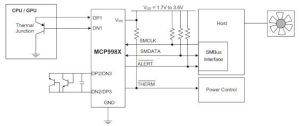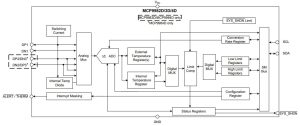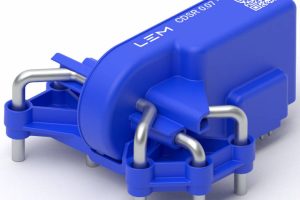Called the MCP998x family, they communicate over a serial bus and a pair of discrete output pins.
 Accuracy is ±1°C max (±0.2°C typ) with the IC and probe diodes anywhere in the range +20°C to +85°C – all can be at different temperatures.
Accuracy is ±1°C max (±0.2°C typ) with the IC and probe diodes anywhere in the range +20°C to +85°C – all can be at different temperatures.
This degrades to ±2.5°C max (±0.4°C typ) with the IC and external probe diodes anywhere from -40°C to +125°C.
The above is with a supply of 3.3V (although operation is possible over 1.7 to 3.6V). Resolution is 0.125°C in all cases.
 Five of the sensors – those with a ‘D’ suffix (left) – have an output (sys-shdn) designed to shut down external hardware in a way that cannot be stopped through software – either maliciously or though a programme flow upset.
Five of the sensors – those with a ‘D’ suffix (left) – have an output (sys-shdn) designed to shut down external hardware in a way that cannot be stopped through software – either maliciously or though a programme flow upset.
This is set between 77 and 112°C by external resistors. (Ed: ingeniously, these are the resistors used to pull-up the open-drain sys-shdn and alert/therm outputs which create a 6bit binary number between them).
Part without the D suffix (top diagram) replace these two outputs with ‘alert’ and ‘therm’ outputs. All four of these outputs are multi-function – view the data sheet to untangle the many options.
“With up to five channels of monitoring and several alert and shutdown options for security, this product family can support systems that supervise more than one thermal element,” said Microchip.
 Some of the ICs can have an option to connected pairs of anti-parallel diodes to some of their inputs – Electronics Weekly has asked what advantage this brings – watch this space.
Some of the ICs can have an option to connected pairs of anti-parallel diodes to some of their inputs – Electronics Weekly has asked what advantage this brings – watch this space.
Diode-connected transistors, for example a 2N3904 emitter-based junction with collector-base shorted, are expected to be used as sensors in many cases.
For this situation, beta compensation is available on some input pins via a register, as is ‘external diode ideality factor’ adjustment.
A register-based correction (‘REC’) is also available for errors due to the resistance of wires and PCB tracks between the IC and the sensed junctions.
Package options are 2 x 2mm WDFN MSOP-8 or 2 x 2.5mm VDFN MSOP-10.
For development, the EV23P16A evaluation board is available.
The devices are “well-suited for automotive applications where operating temperatures for electronics is a major factor,” said Micorchip. “The sensors are designed to support functions including HID lamps, driver-assistance systems, automotive servers, infotainment systems, seat controls and power windows.”
The MCP998x family data sheet is available here – there is a lot going on inside this IC, and the data sheet is well worth a look to understand the non-linearity compensation techniques.
 Electronics Weekly Electronics Design & Components Tech News
Electronics Weekly Electronics Design & Components Tech News



